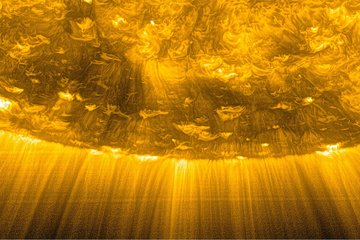A stereo view of the Sun’s magnetic field
Astronomical teamwork: By combining data from Solar Orbiter and SDO, a group of researchers has unambiguously determined the magnetic field at the solar surface.
Two space probes see more than one - especially when they look at their research object from two different directions as is the case for ESA’s Solar Orbiter and NASA’s Solar Dynamics Observatory. A team of scientists led by the Max Planck Institute for Solar System Research (MPS) in Germany has now succeeded in combining observational data from both spacecraft from March of last year in such a way that the magnetic field at the visible surface of the Sun can be unambiguously determined for the first time. About one and a half years ago, the researchers had described the theoretical possibility of such a stereo view of the solar magnetic field. In a recent special issue of the journal Astronomy & Astrophysics devoted to scientific results of the Solar Orbiter mission, they now present practical proof that their method works. With invaluable help from SDO, the Solar Orbiter mission is thus taking a big step towards achieving one of its most important goals: a better understanding of our star’s magnetic nature.

Most space probes and telescopes have a very similar view of the Sun: as they are (almost) all located close to Earth, they see only the Earth-facing side of our star. Ever since its launch about three and a half years ago, ESA's Solar Orbiter spacecraft has been enjoying a completely different sight. Solar Orbiter's unique flight path not only takes the spacecraft very close to the Sun (at times to just a third of the distance between Earth and the Sun), but also on elliptical orbits around our star. This change in perspective offers a fascinating opportunity: together with probes close to Earth, it creates a stereo view of the Sun. A team of scientists, including 21 researchers from the MPS, has now made use of this unique “double view” to overcome one of the major limitations in modern observations of the solar magnetic field.
Blind spot of solar research
The solar magnetic field is considered the key to the dynamic and capricious nature of our star. It controls its eleven-year cycle of activity, produces the sunspots on its surface and is the motor of the sometimes violent solar flares that can even affect Earth in form of solar storms. Unfortunately, all telescopes that measure the magnetic field on their own have a blind spot: Viewed from just one perspective, only the magnetic field component in the direction of observation can be unambiguously determined, but not the direction of the magnetic field component perpendicular to it. Therefore until now, the magnetic field in its entirety could not be fully known. "However, in order for us to understand the behavior of our star, we need to know its magnetic field as precisely as possible," MPS scientist Dr. Gherardo Valori, first author of the current study, explained the scope of the problem.
To deal with this "knowledge gap", scientists have typically made reasonable assumptions about the unknown direction of the transverse magnetic field component. "This is a good and pragmatic approach, but it may provide completely wrong results in key locations", co-author Dr. Étienne Pariat from the Laboratoire de Physique des Plasmas in France said. Only two space probes working as a team and simultaneously looking at the Sun from two different perspectives can provide a real solution. "The observational data from one probe can compensate for the blind spot of the other - and vice versa," Prof. Dr. Sami K. Solanki, director at MPS and Principle Investigator of Solar Orbiters Polarimetric and Helioseismic Imager (PHI) explained. In this way, all components of the magnetic field can be determined from observational data alone.
A year and a half ago, the researcher and his colleagues showed in theoretical calculations that this basic idea can work when applied to data from Solar Orbiter and SDO. Now the team has been able to provide proof with the help of real observations.
A double view of an active region
The scientists analyzed data from March 17 of last year. At that time, Solar Orbiter was only a little more than a third of the Sun-Earth distance from the Sun. On that day, Solar Orbiter's instrument PHI, which was developed and built under the leadership of the MPS, observed active region AR12965 on the surface of the Sun. Active regions are characterized by particularly strong and complex magnetic fields; they frequently contain sunspots and often produce the largest solar flares. At the same time, SDO's Helioseismic and Magnetic Imager (HMI) looked at the same region - from an angle of 27 degrees to Solar Orbiter. "The two instruments not only had different perspectives, but also very different distances from the Sun. Therefore, the resolution of the data also differs significantly", Valori explains the exact circumstances. In addition, the two instruments were calibrated differently. But despite these difficulties, the researchers' efforts were successful, and the sunspot magnetic field could be fully determined using observations only.
The team is optimistic that their method can also be applied to regions with weaker magnetic fields. For the future, the scientists also set their hopes on measurements from a forthcoming new ESA spacecraft, Vigil, that will follow Earth on its orbit around the Sun in a distance of approximately 150 million kilometers thus allowing for a continuous look at the side of the Sun – and in tandem with other spacecraft another stereo view of our star.











